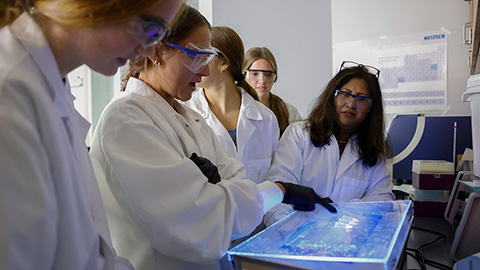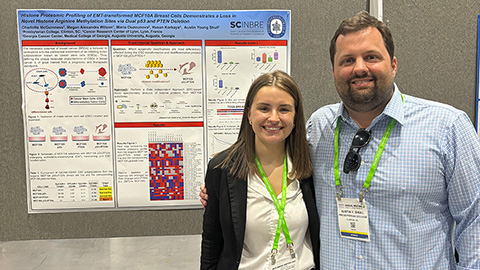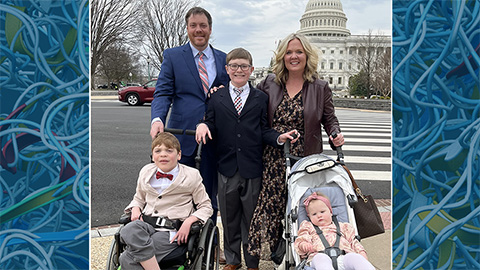
Evolutionary constraints on disordered proteins
Roughly 40% of the proteome is intrinsically disordered; these proteins and domains behave differently from structured proteins, rarely adopting just one stable structure. Instead, it can be useful to think of them dynamically moving through a wide range of favorable conformations known as an ensemble.

Many structured proteins are under evolutionary pressure that constrains how much they can change over time. Too large a shift in amino acid sequence may compromise function, unless a secondary change happens to compensate. For intrinsically disordered proteins, however, it is more difficult to determine whether ensembles undergo the same selection pressure. Multiple sequence alignments often show significant changes to a disordered region’s primary amino acid sequence, sometimes including dramatic changes in length.
“If a protein is under selection, you expect (sequence) conservation, and we couldn’t see it,” said Lucía Chemes, a professor at Argentina’s Universidad Nacional de San Martín. Still, studies of disordered proteins have made it clear over time that they have important conserved functions. Chemes said, “There’s evidence that there must be conservation of function — so how does this happen, if the sequence changes so much?”
To find out, Chemes’ team chose as a model system an adenovirus protein that disrupts a host transcription–repression complex. The viral protein must work rapidly early in infection, when its levels are low, to hijack the host cell cycle. Therefore, high-affinity binding is very important.
How much the viral protein can disrupt the complex depends on two short linear motifs that associate directly with the translation repressor, but the lab found that the strength of binding is also governed by an intrinsically disordered region that connects the two linear motifs. Using proteins constructed of the two motifs separated by different linkers, the researchers confirmed that the linkers have the optimal length to tether the linear motifs closely enough together to reach their binding sites and boost binding affinity at both sites. Any longer, and the linear motifs could flop through too many conformations, missing their binding target, while a shorter linker prevented both linear motifs from binding at once.
When comparing homologous proteins from viruses targeting different mammalian species, whose linear sequences varied in length from 40 to 75 amino acids, the lab was surprised to find that all-atom structural modeling predicted a consistent end-to-end distance. Closer packing and lower density of charge per residues enabled longer linear sequences to pack into the same length as shorter ones. That confirmed that evolutionary constraints on the ensemble structure ensured its function, even when its sequence fluctuated.
“It’s clear that there’s more conserved than meets the eye when you see an alignment,” Chemes said. But the conserved feature defining an ensemble may not always be end-to-end distance. The next challenge for the field will be to identify the features that need to be conserved in each intrinsically disordered protein.
Enjoy reading ASBMB Today?
Become a member to receive the print edition four times a year and the digital edition monthly.
Learn moreGet the latest from ASBMB Today
Enter your email address, and we’ll send you a weekly email with recent articles, interviews and more.
Latest in Opinions
Opinions highlights or most popular articles

Debugging my code and teaching with ChatGPT
AI tools like ChatGPT have changed the way an assistant professor teaches and does research. But, he asserts that real growth still comes from struggle, and educators must help students use AI wisely — as scaffolds, not shortcuts.

AI in the lab: The power of smarter questions
An assistant professor discusses AI's evolution from a buzzword to a trusted research partner. It helps streamline reviews, troubleshoot code, save time and spark ideas, but its success relies on combining AI with expertise and critical thinking.

How AlphaFold transformed my classroom into a research lab
A high school science teacher reflects on how AI-integrated technologies help her students ponder realistic research questions with hands-on learning.

Writing with AI turns chaos into clarity
Associate professor shares how generative AI, used as a creative whiteboard, helps scientists refine ideas, structure complexity and sharpen clarity — transforming the messy process of discovery into compelling science writing.

Teaching AI to listen
A computational medicine graduate student reflects on building natural language processing tools that extract meaning from messy clinical notes — transforming how we identify genetic risk while redefining what it means to listen in science.

What’s in a diagnosis?
When Jessica Foglio’s son Ben was first diagnosed with cerebral palsy, the label didn’t feel right. Whole exome sequencing revealed a rare disorder called Salla disease. Now Jessica is building community and driving research for answers.

